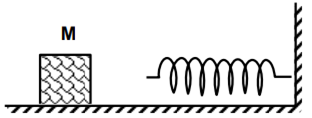Out of the following pair, which one does NOT have identical dimensions is
angular momentum and Planck’s constant
impulse and momentum
moment of inertia and moment of a force
moment of inertia and moment of a force
C.
moment of inertia and moment of a force
A bullet fired into a fixed target loses half of its velocity after penetrating 3 cm. How much further it will penetrate before coming to rest assuming that it faces constant resistance to motion?
3.0 cm
2.0 cm
1.5 cm
1.5 cm
D.
1.5 cm

The block of mass M moving on the frictionless horizontal surface collides with a spring of spring constant K and compresses it by length L. The maximum momentum of the block after collision is

KL2/2M
zero
zero
A.


A particle of mass 0.3 kg is subjected to a force F=−kx with k=15 N/m. What will be its initial acceleration if it is released from a point 20 cm away from the origin?
3 m/s2
15 m/s2
5 m/s2
5 m/s2
D.
5 m/s2
a = kx/m =10m /s2
A body A of mass M while falling vertically downwards under gravity breaks into two parts; a body B of mass 1/3 M and a body C of mass 2/3 M. The centre of mass of bodies B and C taken together shifts compared to that of body A towards
depends on height of breaking
does not shift
body C
body C
B.
does not shift
No horizontal external force is acting
∴ = acm =0
since vcm= 0
∴∆xcm = 0
